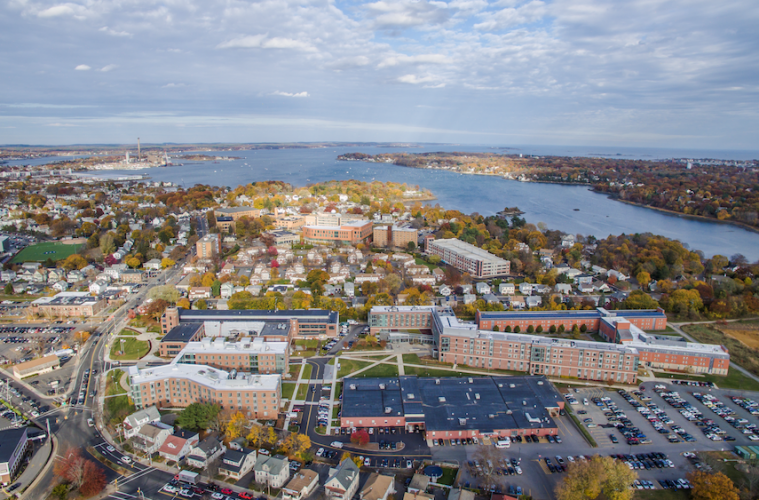Salem State University released a Vision for a Sustainable Future today that outlines its plans to adapt academic programs and student services to better meet the needs of current and future students. The Vision uses data about student academic interests and student support needs to guide a reorientation of the university during a time of change for Salem State, the North Shore, and the higher education sector.
“Higher education was at a crossroads even before COVID-19 emerged, and the pandemic has accelerated the pace of change,” says President John Keenan. “This moment gives us a chance to reflect and make sure everything we do on campus is aligned with the interests and needs of our students today and in the future.”
Diversity
Today, Salem State serves 3,000 fewer students than it did just a decade ago, and its student body is increasingly diverse, Pell eligible, and made up of students who are in the first generation of their family to attend college. Currently, nearly 40 percent of Salem State students identify as students of color, 35 percent are first generation to college, and 37 percent are Pell eligible.
The Vision includes focusing resources toward student support services, working to close student opportunity gaps by 2030, preparing to become a federally designated Hispanic Serving Institution, and adding faculty in academic growth areas.
Salem State plans to create the Viking Success Collaborative, which will streamline efforts in the areas of enrollment management, admissions, academic advising and support areas, inclusive excellence, and student life to create a more seamless student experience. The university will also follow the Moon Shot for Equity framework, an initiative and collaboration with educational consulting firm EAB aimed at closing opportunity gaps by 2030. These efforts will work in tandem with Salem State preparing to become a Hispanic Serving Institution (HSI).
HSI status is a designation by the U.S. Department of Education for institutions at which at least 25 percent of undergraduate full-time equivalent students identify as Hispanic. Salem State currently serves a 20 percent Latinx student population, and regional demographic trends indicate that this percentage is likely to grow. This Vision provides a pathway for Salem State to better serve these students in the future, efforts that university leaders believe will benefit the entire student body.
Faculty and Academic Growth
The Vision for a Sustainable Future includes plans to better align resources with student interests when it comes to academic programming, while meeting the region’s workforce needs. Salem State plans to hire additional faculty members in academic areas of high demand that currently have need. The university will also work with under-enrolled academic departments to invigorate offerings to draw additional student interest. Any changes to academic programs will take time and follow a collaborative process that includes the faculty, the department chairpersons, the university’s shared governance committees, the deans and the provost. Current students and those who have been accepted for the fall of 2021 will be able to complete their degree in their chosen major.
Since the fall of 2015, 60 percent of Salem State degrees were in the five academic areas of business, education, nursing, psychology, and social work. Conversely, there are nine academic programs at the university that account for only five percent of degrees awarded. Salem State is committed to educating the whole student even as it adapts to students’ learning choices.
Salem State’s efforts to offer more support to academic growth areas align with its goal of preparing to become a Hispanic Serving Institution, as 80 percent of current Latinx students are enrolled in the university’s top 10 highest-demand programs.
The Vision for a Sustainable Future ties in with Salem State’s existing application with the Massachusetts Division of Capital Asset Management and Maintenance (DCAMM) to help fund SSU BOLD: A Campus Unification and Modernization Project (SSU BOLD). This project is designed to enhance the overall campus experience for all students, support their interests and position Salem State to continue preparing the North Shore’s future workforce.
The Vision for a Sustainable Future does not include involuntary personnel reductions but references the possibility of such reductions in the future if the Vision is not successful in stabilizing enrollment. In addition to hiring faculty members, the university plans to add staff in the revenue growth areas of admissions, institutional advancement and marketing.
The university cited a number of unknowns about the year ahead that could bring positive outcomes—including uncertainty about upcoming state and federal funding, possible savings from voluntary departures, and the impact of widespread COVID-19 vaccinations on enrollment—as reasons to avoid involuntary personnel reductions at this time.
The Vision responds to the changing higher education landscape that has prompted colleges and universities across the country to evolve. Salem State’s enrollment faces retention challenges, changing demographics, declining community college enrollments that produce far fewer transfer students, and the success of the university increasing its graduation rate. The university’s personnel reductions have not kept pace with declining enrollment, and compensation makes up 70 percent of the university’s expenses.
Salem State plans to continue its disciplined management of faculty and staff positions that has helped to reduce compensation costs in recent years and allowed the university to avoid involuntary personnel reductions to date. This approach has included a hiring freeze, eliminating vacant positions, and voluntary separation incentives.
The Vision was crafted by university leadership and builds on suggestions from a 34-member Sustainable Path Forward Task Force convened late last year. University leaders will seek feedback from the campus community on the Vision before finalizing it this spring.
The detailed Vision for a Sustainable Future is available at salemstate.edu/vision, along with an FAQ.

